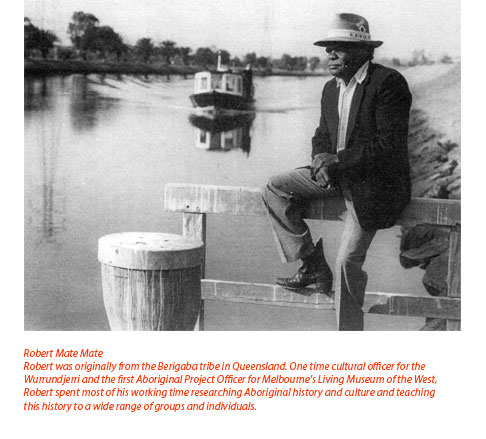Panel 10 – Education
In the nineties efforts are being made in a range of ways and by a range of organisations and individuals to research and teach Aboriginal heritage and history in the western region of Melbourne.
In conjunction with this research are moves to educate both Aboriginal and non-Aboriginal people about Aboriginal presence and culture both from the past and in the present.
Part of the impetus for these moves came from recommendations made in the Miller Report in 1954 and the Deaths in Custody Report in 1993. Part of the recommendations from these reports was that Aboriginal people should be educated in Aboriginal culture.

There have been several major problems with educating both Aboriginal and non Aboriginal people about Aboriginal presence and culture in this region.
Most of the indigenous local culture of the western region of Melbourne was wiped out with the people who were killed. Much of the rest was destroyed by the assimilation practices of the missions. Most Aboriginal people from this region know very little of their own cultural history.
What little is known has been inaccessible, in academic documents and expressed through European forms. The traditional methods of passing on culture have been obliterated or discredited.
Despite the recent recommendations of several reports and policies to redress this situation the resources have been limited in putting such policies into action.
On top of all this an issue for Melbourne’s Western Region ie that until recently neither white nor black organisations considered the western suburbs was an area with an Aboriginal community of any nature so what little resources have been available have been slow to reach this region.

It is scandalous that Aboriginal culture is not a basic curriculum item in education today (1996).
While there are many support programs available to Aboriginal and Torres Strait Islander people it would appear that within the western suburbs these programs are under-utilised. There is a lack of information about these resources and many Aboriginal and Islander People do not know who to contact about bringing these programs into their schools or how to utilise them for their children.
A major problem of introducing Aboriginal Studies into a school curriculum in this State today is both faced by the schools and placed in the hands of the schools themselves. Many schools are having great difficulty deciphering the current ‘guidelines’ and ‘information* implemented by the State Government that are set out to explain; how a school can gain access to the resources and people that are available to their school, and how a school can introduce an Aboriginal Studies program efficiently within their schools over-all administration policies and budget.
The Catholic Aboriginal Education Unit has successfully introduced Aboriginal Studies programs into many primary schools in the western suburbs. Apparently these programs are working cost effectively for these schools, and at the same time are enriching the students education, lives and the students relationship to their country.
Before the 1970s very little Aboriginal history and culture was being taught, especially local culture, within schools in the western suburbs of Melbourne.
However there were a few Aboriginal people who did go to the schools in this region. They taught not so much about the history of the Aboriginal and Islander people (these subjects were not a part of school curriculum at the time) they tried to let people know that Aboriginal people were still alive and living in Victoria and still maintaining their identity and culture.
Aboriginal organisations such as the Advancement League, and people such as Eric Onus, Harold Blair, Wally Cooper and many others, came here to talk about and demonstrate their culture. These were the first instances of Aboriginal culture entering schools. Today schools in the west (if they want, and if they can decipher how to) have access to people such as Robert Mate-Mate, Melissa Brickell, Kim Jowett, Paul Richardson, Stan Dryden and a host of Aboriginal organisations including; the Catholic Aboriginal Education Unit, the Victorian Aboriginal Education Ass. Inc., the Koori Education Co-ordination Unit, the Koori Development and Support Unit of the V.U.T., the Werribee Local Aboriginal Education Co-ordinating Group, and the Council of Adult and Further Education’s Koori Studies and Support Unit.
Larry Walsh and many others are going into schools to talk with students and share their histories and cultures. Aboriginal people are available to help schools develop and incorporate Aboriginal studies and local Aboriginal History into their schools curriculum.
All these groups and people are not only working with the schools to help with Aboriginal Education, they also lobby for more resources, programs and courses to assist local Aboriginal and Islander people in helping to improve their education as a means of helping to empower people themselves.
They are also involved in cross cultural workshops with non-Aboriginal people so that teachers and educators can begin to understand local Aboriginal and Islander people and their cultures and ways of life.
